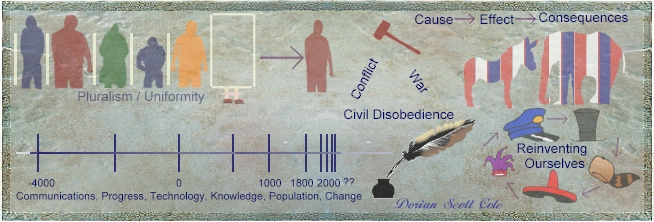
Over 400 articles
|
Remodeling. Please pardon the heterogeneity and potsherds. < ; )

Journalism
Journalism
Journalism
Established 1996
Over 400 articles
Journalism Series
|


The End - pie and coffee
Come for the meal, stay for the pie and coffee.Pie and coffee have a lot of symbolic meaning in people's lives. Coffee symbolizes musings and discussion - chit chat between friends. It is our way of exploring things and coming to understand them. Pie is the sweet thing that ends a meal. It adds a sense of peacefulness and closure. We want the same thing at the end of a story.
"The End" at the end of a story is not the resolution. "The ending," is transitive - it is a transition, a period of time in which things are concluded. The effect of the event is seen or speculated about. After the climax (when someone clearly wins), the event has an effect on people's lives - an outcome. Outcomes. After Johnny is freed from the torture of being falsely imprisoned, he goes to college. After Paula's child survives the horrendous operation, Paula takes her to school. After losing in a terribly expensive court battle, John feels he can hardly survive financially. After winning a huge lottery, Michael is flat broke in three months. In stories, the conflict or emotional peak is resolved, and the continuing implications are that life is reaffirmed, or we are given a warning, or we learn something important. The outcome, or potential outcome, carries much more meaning than the event. In a story, the resolution contains the future implications. It answers the question, "What does this mean to me?" Resolution: How does the story end (if it does), and what does it mean to us? Some stories are tragic and tell us to watch out. Other stories are life-affirming and assure us that things will work out (the pie). Some stories simply transport us to another place mentally and emotionally, and entertain us. All are important. It's even more interesting when reporters and anchors end with personal musings or question each other lightly about the ending and what it means in people's lives (the coffee). Similar techniques are used to good effect (at this writing) on several news shows, such as 20/20, CBS Evening News, CNN Headline News, and Fox and Friends. A story ends in the resolution. Resolution: Main Entry: res·o·lu·tion A communicator serves the full meal. Not just the headline, not just the meat of the story, not just the coffee, but the pie, too.
The job of a communicator is to bring things into focus. He doesn't talk about all of the stones in the universe, he talks about the one that killed Goliath and how that will change the course of history. He doesn't talk about all of the thieves in the world, he talks about the one who is using a new way to rob you, and what you can do to prevent it. He doesn't talk about all of the politicians in the Senate, he talks about the one who is trying to cut your taxes and how much extra money you will have to spend each year. Communicators architect stories so that they focus in on what is important - focus so they have impact. If it is newsworthy, it is because it has impact in people's lives. If it is going to have impact in people's lives, then it should be in the news. If it is an event, then the communicator has to figure out what impact it may have in people's lives.
|
|||||||||
- Scott
Also see these previous articles:
References:
Other distribution restrictions: None